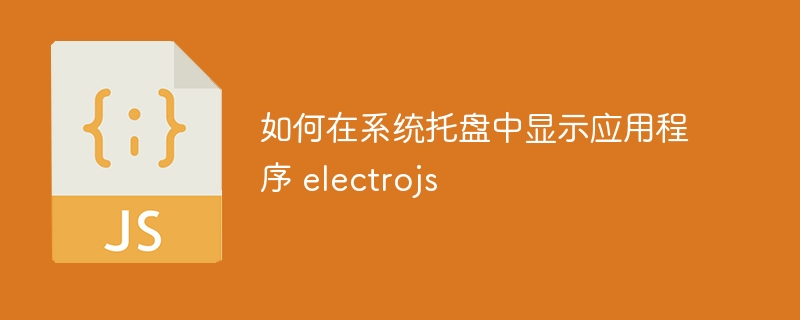如何在系统托盘中显示应用程序 electrojs
来源:dev.to
时间:2024-07-12 08:54:55 389浏览 收藏
大家好,我们又见面了啊~本文《如何在系统托盘中显示应用程序 electrojs》的内容中将会涉及到等等。如果你正在学习文章相关知识,欢迎关注我,以后会给大家带来更多文章相关文章,希望我们能一起进步!下面就开始本文的正式内容~

介绍
electron js 是一种流行的框架,用于使用 javascript、html 和 css 等 web 技术构建桌面应用程序。桌面应用程序的重要功能之一是能够将它们与系统托盘集成,从而允许用户轻松访问关键功能和设置。本文将指导您创建一个 electron js 应用程序并将其与系统托盘集成。
在系统托盘中显示应用程序
要在系统托盘中显示您的应用程序,您需要从 electron 创建 tray 类的实例。此实例将在系统托盘中用图标代表该应用程序。
将以下行添加到 main.js 文件中:
const { app, browserwindow, tray, menu } = require('electron');
let mainwindow;
let tray;
app.on('ready', () => {
mainwindow = new browserwindow({
width: 800,
height: 600,
webpreferences: {
nodeintegration: true
}
});
mainwindow.loadfile('index.html');
createtray();
});
function createtray() {
tray = new tray('path/to/icon.png'); // path to your tray icon
const contextmenu = menu.buildfromtemplate([
{
label: 'show app',
click: () => {
mainwindow.show();
}
}
]);
tray.settooltip('my electron app');
tray.setcontextmenu(contextmenu);
}
自定义图标
要更改托盘图标,请更新托盘构造函数中的路径:
tray = new tray('path/to/new_icon.png');
确保路径指向要用作托盘图标的有效图像文件。
添加显示、隐藏和退出按钮
为了增强系统托盘菜单的功能,您可以添加显示、隐藏和退出应用程序的选项。修改main.js文件如下:
const { app, browserwindow, tray, menu } = require('electron');
let mainwindow;
let tray;
app.on('ready', () => {
mainwindow = new browserwindow({
width: 800,
height: 600,
webpreferences: {
nodeintegration: true
}
});
mainwindow.loadfile('index.html');
createtray();
});
function createtray() {
tray = new tray('path/to/icon.png'); // path to your tray icon
const contextmenu = menu.buildfromtemplate([
{
label: 'show app',
click: () => {
mainwindow.show();
}
},
{
label: 'hide app',
click: () => {
mainwindow.hide();
}
},
{
label: 'exit',
click: () => {
app.quit();
}
}
]);
tray.settooltip('my electron app');
tray.setcontextmenu(contextmenu);
}
解释
- 显示应用程序按钮:
{
label: 'show app',
click: () => {
mainwindow.show();
}
}
单击此菜单项将使应用程序的窗口重新显示出来。
- 隐藏应用程序按钮:
{
label: 'hide app',
click: () => {
mainwindow.hide();
}
}
此菜单项会将应用程序最小化到系统托盘,将其从任务栏隐藏。
- 退出按钮:
{
label: 'exit',
click: () => {
app.quit();
}
}
选择此菜单项将关闭应用程序。
完整的上下文菜单示例
您可以通过添加更多选项来进一步自定义上下文菜单,例如打开设置窗口或显示应用程序信息。
const { app, BrowserWindow, Tray, Menu } = require('electron');
let mainWindow;
let tray;
app.on('ready', () => {
mainWindow = new BrowserWindow({
width: 800,
height: 600,
webPreferences: {
nodeIntegration: true
}
});
mainWindow.loadFile('index.html');
createTray();
});
function createTray() {
tray = new Tray('path/to/icon.png'); // Path to your tray icon
const contextMenu = Menu.buildFromTemplate([
{
label: 'Show App',
click: () => {
mainWindow.show();
}
},
{
label: 'Hide App',
click: () => {
mainWindow.hide();
}
},
{
label: 'Settings',
click: () => {
// Open a settings window
}
},
{
label: 'About',
click: () => {
// Show about information
}
},
{
label: 'Exit',
click: () => {
app.quit();
}
}
]);
tray.setToolTip('My Electron App');
tray.setContextMenu(contextMenu);
}
结论
按照以下步骤,您可以使用 electron js 创建一个与系统托盘无缝集成的桌面应用程序。这种集成通过直接从系统托盘轻松访问基本应用程序功能来增强用户体验。无论是显示、隐藏还是退出应用程序,系统托盘都为用户与您的应用程序交互提供了便捷的方式。
以上就是本文的全部内容了,是否有顺利帮助你解决问题?若是能给你带来学习上的帮助,请大家多多支持golang学习网!更多关于文章的相关知识,也可关注golang学习网公众号。
-
502 收藏
-
501 收藏
-
501 收藏
-
501 收藏
-
501 收藏
-
316 收藏
-
135 收藏
-
408 收藏
-
263 收藏
-
247 收藏
-
361 收藏
-
353 收藏
-
293 收藏
-
191 收藏
-
207 收藏
-
439 收藏
-
465 收藏
-

- 前端进阶之JavaScript设计模式
- 设计模式是开发人员在软件开发过程中面临一般问题时的解决方案,代表了最佳的实践。本课程的主打内容包括JS常见设计模式以及具体应用场景,打造一站式知识长龙服务,适合有JS基础的同学学习。
- 立即学习 543次学习
-

- GO语言核心编程课程
- 本课程采用真实案例,全面具体可落地,从理论到实践,一步一步将GO核心编程技术、编程思想、底层实现融会贯通,使学习者贴近时代脉搏,做IT互联网时代的弄潮儿。
- 立即学习 516次学习
-

- 简单聊聊mysql8与网络通信
- 如有问题加微信:Le-studyg;在课程中,我们将首先介绍MySQL8的新特性,包括性能优化、安全增强、新数据类型等,帮助学生快速熟悉MySQL8的最新功能。接着,我们将深入解析MySQL的网络通信机制,包括协议、连接管理、数据传输等,让
- 立即学习 500次学习
-

- JavaScript正则表达式基础与实战
- 在任何一门编程语言中,正则表达式,都是一项重要的知识,它提供了高效的字符串匹配与捕获机制,可以极大的简化程序设计。
- 立即学习 487次学习
-

- 从零制作响应式网站—Grid布局
- 本系列教程将展示从零制作一个假想的网络科技公司官网,分为导航,轮播,关于我们,成功案例,服务流程,团队介绍,数据部分,公司动态,底部信息等内容区块。网站整体采用CSSGrid布局,支持响应式,有流畅过渡和展现动画。
- 立即学习 485次学习
